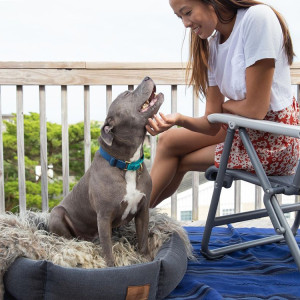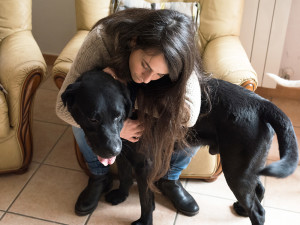Dog Arthritis Treatment: How to Relieve Arthritis Pain in Dogs
Tips for treating achy joints — from medications to massages.

share article
Arthritis is a common condition that can affect dogs of all ages, but it is especially common in older dogs. Arthritis occurs when the cartilage in the joints breaks down, causing pain and inflammation. Early diagnosis and treatment of arthritis can help to improve your dog's quality of life and slow the progression of the disease.
What is arthritis?
Arthritis refers to a degenerative condition in which joints lose cartilage, form bone spurs, and develop fibrosis (hardening). Arthritis in dogs is also known as osteoarthritis (OA) and degenerative joint disease (DJD).
Cartilage is the smooth, flexible material that covers the surface of bones where they meet other bones at joints. Joints are enclosed in a joint capsule, which produces a very slippery fluid that keeps the surface of the cartilage lubricated. The combination of a smooth surface and slippery fluid allows the bone ends to glide across each other effortlessly. Cartilage also functions as a shock absorber, protecting the bones by dissipating some of the force from falls or sudden hits.
With age, trauma, or medical conditions, cartilage can be damaged or break down over time, leading to the development of osteoarthritis. Arthritis is not reversible and is generally considered to be a progressive disease. Disease management is aimed at reducing pain and slowing or preventing additional damage to joints. Arthritis tends to perpetuate itself because injury to the cartilage leads to the release of additional substances that further break down cartilage.
Some of the signs of arthritis are due to the body’s response to cartilage injury. Cartilage destruction and the substances released by damaged cartilage cells trigger the dog's body to form new bony tissue, reinforcing/hardening the tissues around injured joints in an attempt to provide joint stability. Unfortunately, these bone spurs and fibrotic joints can reduce mobility and create pain.
What are the types of arthritis in dogs?
There are many types of dog arthritis, but some of them can be difficult to tell apart without extensive testing. The most common ones are types of degenerative joint disease. DJD can occur as a primary disease that is normally associated with aging. It can also be triggered by joint injury or secondary to genetic or congenital issues like elbow or hip dysplasia.
Less common forms of arthritis in dogs include immune-mediated arthritis and septic (infectious) arthritis. These tend to have a much quicker progression than DJD, and they are treated very differently.
What are the signs of arthritis in dogs?
Many pet parents see the signs of dog arthritis early but attribute them to normal aging changesopens in a new tab. While it’s true that arthritis is more common with ageopens in a new tab, it doesn’t mean that it should be considered normal. Early recognition of the symptoms of arthritis in your dog can help give them more time with less pain and more mobility. Signs of arthritis to watch out for include:
Decreased activity
Difficulty changing positions between sitting, laying, and rising
Decreased willingness to play
Stiffness when walking
Limping
Joint creaking or cracking
Joint swelling
Muscle wasting
Seeing these symptoms may cause some worry about arthritis in your dog. Arthritis cannot be diagnosed on sight alone, so setting up a visit with your veterinarian is the best way to find out what is going on and how to treat it.
How is arthritis diagnosed in dogs?
The diagnosis of dog arthritis usually involves a combination of physical examination and joint radiographs (x-rays). Additional tests like examination of joint fluid, a CT scan, and kinetic testing may be recommended if more information is needed. Most dogs with arthritis can be diagnosed with basic testing available at your vet.
After gathering a history to see if the symptoms you’re seeing at home fit with arthritis or any other conditions, your veterinarian will examine your dog. During a physical exam, your veterinarian will check your dog’s joints for signs of pain, swelling, instability, or crepitus (an abnormal sound or rubbing feeling when a joint is put through its range of motion). They may also evaluate your dog’s gait for a limp and check for muscle atrophy.
Radiographs of joints that are causing problems may show signs of joint swelling, development of bone spurs, or hardening of bone beneath the cartilage. Radiographs can also show if there are joint changes like elbow or hip dysplasia that could be triggering arthritis. Many dogs will need sedation to obtain good radiographs — this allows proper positioning of joints without causing your dog extra pain.
How is dog arthritis treated?
Unfortunately, there’s no dog arthritis cure out there. Fortunately, there are many things you can do to slow the progression of arthritis and keep your dog comfortable. The treatment for a dog with arthritis will vary based on the severity of the arthritis, their mobility, and their overall health picture. A comprehensive treatment plan for canine arthritis will often involve weight management, appropriate exercise, pain control medications, and joint supplements.
Dogs that are showing signs of arthritis pain can benefit from pain medications like NSAIDs (non-steroidal anti-inflammatory drugs). There are many different NSAIDs made for dogs, and none of the over-the-counter ones (including “dog aspirinopens in a new tab” products) are safe for dogs. Some dogs with late-stage arthritis may need NSAIDs twice daily, while others with less severe disease may only need them when they’re having bad days due to flare-ups. Your veterinarian can help you find a medication and dose that works for your dog.
Some dogs will benefit from an adjunct pain medication as well. While these medications do not provide the reduction in inflammation that NSAIDs do, they can help modulate the way the body perceives and processes pain. Drugs like gabapentin, amantadine, and amitriptyline are often used chronically to help manage arthritis pain.
There are also many supplementsopens in a new tab aimed at protecting cartilage available. Adequanopens in a new tab is an injection approved for dogs that provides some of the building blocks for cartilage repair. Oral joint supplements have mixed data on effectivenessopens in a new tab overall, but adding a fish oil product to your dog’s diet is likely to help.
How do you manage symptoms of arthritis in dogs?
Caring for a dog with arthritis can create some challenges for their parents. Despite the difficulties, creating an effective arthritis strategy can be very rewarding for both dogs and their parents. Finding a routine and management plan that gets your stiff, sore dog to be mobile and active again feels great.
Providing orthopedic bedding helps to take pressure off sore joints. Covering slick floors in your dog’s favorite areas with rugs or other textured surfaces can help to prevent falls and make them feel more confident walking around. Small dogs can be carried up and down stairs, but larger dogs will benefit from ramps to help them get around.
A low-impact exercise plan appropriate for your dog’s condition can be developed by consulting with your vet or a canine rehabilitation specialist. Rehab specialists also often have access to equipment like water treadmills, therapeutic lasers, and balance balls that can help reduce pain and rebuild muscle. Some even offer acupunctureopens in a new tab or therapeutic massageopens in a new tab to help keep your dog comfortable.
Can arthritis be prevented in dogs?
There’s no definitive way to prevent arthritis in dogs. Recognizing risk factors like obesityopens in a new tab, joint trauma, or developmental joint issues can alert you to be on the watch for issues. Dog arthritis prevention is focused on limiting the progression of the disease. Early detection of arthritis allows therapies aimed at slowing the disease to be initiated before the damage is out of control.
Other factors that affect your dog’s ioint health
Arthritis in dogs doesn’t occur in a vacuum. While the disease cannot be prevented, you can take steps early in your dog’s life to limit and delay the damage arthritis can do to your dog’s joints. Some of the most important factors include:
Body weight
Lean dogs live longeropens in a new tab. They also tend to develop arthritis later in life than overweight dogs. The joints of overweight dogs have to absorb the force created by that extra weight. This creates more wear and tear on joints and predisposes them to injury. Once arthritis has developed, carrying extra weight creates additional problems by reducing mobility and increasing the production of inflammatory factors in the body.
The best thing to do is to keep your dog at a healthy body weight throughout their life. That’s easier said than done for many dogs and their parents. But if your dog is a little chubby when they’re diagnosed with arthritis, developing a plan to get that extra weight off can get your dog feeling better quickly. Arthritic dogs with as little as a 6.1 percent lossopens in a new tab in body weight showed signs of increased mobility and activity.
Genetics
Dogs can be predisposed to certain orthopedic problems due to inherited traits. Two of the most common genetic conditions are hip dysplasia and elbow dysplasia. Hip dysplasia causes increased laxity in the hip joint and is more common in large breed dogs. Elbow dysplasia can be caused by up to four developmental abnormalities affecting the elbow joint. This condition affects many breeds but is more common in large and giant breed dogs. Both hip and elbow dysplasia commonly lead to arthritis.
Injuries
Direct trauma to joints can damage cartilage and initiate the progression of arthritis. But arthritis can develop due to injuries to other areas as well. Pain, mobility restrictions, and improper bone healing can all lead a dog to bear weight on their joints differently. This changes the way that weight is borne on the cartilage of the joints and can cause arthritis due to wear on areas of bone less protected by cartilage.
Your veterinarian may pick up on arthritic changes affecting your dog during a routine examination, but you can often pick up on changes earlier. Because you’re with your dog every day and know them better than anyone, you’re in the best position to detect subtle changes that could indicate arthritis. Schedule an appointment with your vet if you see signs associated with arthritis. Setting up a management planopens in a new tab early can slow progression and keep your dog comfortable and active.
FAQs (People also ask):
Can diet help manage arthritis in dogs?
Diet is a major component of arthritis management in dogs. Maintaining a lean body weight is vital to keeping dogs with arthritis comfortable and mobile. Some prescription diets even contain additives to help slow the progression of arthritis.
Is arthritis in dogs a progressive condition?
Dog arthritis is a progressive condition. The damage to the joints of dogs creates inflammation and leads to further tissue changes. Developing a treatment and management plan with your veterinarian is the best way to slow this progression.
Are there certain breeds that are prone to arthritis?
All dogs can get arthritis, but large and giant breed dogs are more prone to some inherited conditions that lead to arthritis in the elbows and hips.
References:
Kathy Davieds, DVM
Kathy Davieds, DVM has been a small-animal veterinarian for 25 years. Active in therapy-dog work, rescue and other canine endeavors, she is also founder of the Virginia Partnership for Animal Welfare and Support. She is currently owned by several uncropped Dobes.
Related articles
![Sad boxer rests on owners lap, dog doesn't want to be touched]() opens in a new tab
opens in a new tabDon’t Ignore These 9 Behavioral Signs That Your Dog Is in Pain
Animal behaviorist Karen B. London breaks down the silent ways your pet is trying to tell you they’re hurting.
![Small black pug in a red banana sitting in grass and looking up at camera, dogs eyes getting cloudy]() opens in a new tab
opens in a new tabEverything You Need to Know About Cataracts in Dogs
Here’s how to spot the eye condition and help your dog see more clearly.
![a pair of English cream retriever dogs wiggle around on their backs with big grins on their faces]() opens in a new tab
opens in a new tab80% of Dogs Have a Dental Disease — Does Yours?
Here are four common dental problems your pup might face and how to treat them.
![brown puppy eating food out of green bowl]() opens in a new tab
opens in a new tabA Digestible Guide to Healthy Dog Food
How to pick the right grub for your pup when there are So. Many. Choices.
![A woman hugging a black lab in her arms.]() opens in a new tab
opens in a new tabEverything to Know About Canine Mast Cell Tumors to Keep From Freaking Out
The sooner you catch this common cancer, the better your chances are for giving your dog many more happy, healthy years.
![Old dog being pet by person]() opens in a new tab
opens in a new tabWhy You Should Adopt a Senior Dog This Month
November is Adopt a Senior Pet Month. Here are all the reasons you should welcome a senior pup into your family.













